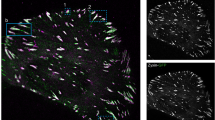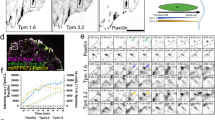Abstract
Here we use time-lapse microscopy to analyse cell–matrix adhesions in cells expressing one of two different cytoskeletal proteins, paxillin or tensin, tagged with green fluorescent protein (GFP). Use of GFP–paxillin to analyse focal contacts and GFP–tensin to study fibrillar adhesions reveals that both types of major adhesion are highly dynamic. Small focal contacts often translocate, by extending centripetally and contracting peripherally, at a mean rate of 19 micrometres per hour. Fibrillar adhesions arise from the medial ends of stationary focal contacts, contain α5β1 integrin and tensin but not other focal-contact components, and associate with fibronectin fibrils. Fibrillar adhesions translocate centripetally at a mean rate of 18 micrometres per hour in an actomyosin-dependent manner. We propose a dynamic model for the regulation of cell–matrix adhesions and for transitions between focal contacts and fibrillar adhesions, with the ability of the matrix to deform functioning as a mechanical switch.
This is a preview of subscription content, access via your institution
Access options
Subscribe to this journal
Receive 12 print issues and online access
$209.00 per year
only $17.42 per issue
Buy this article
- Purchase on Springer Link
- Instant access to full article PDF
Prices may be subject to local taxes which are calculated during checkout







Similar content being viewed by others
References
Howe, A., Aplin, A. E., Alahari, S. K. & Juliano, R. L. Integrin signaling and cell growth control. Curr. Opin. Cell Biol. 10, 220–231 (1998).
Gumbiner, B. M. Cell adhesion: the molecular basis of tissue architecture and morphogenesis. Cell 84, 345–357 (1996).
Yamada, K. M. & Geiger, B. Molecular interactions in cell adhesion complexes. Curr. Opin. Cell Biol. 9, 76–85 (1997).
Clark, E. A. & Brugge, J. S. Integrins and signal transduction pathways: the road taken. Science 268, 233–239 (1995).
Schoenwaelder, S. M. & Burridge, K. Bidirectional signaling between the cytoskeleton and integrins. Curr. Opin. Cell Biol. 11, 274–286 (1999).
Jockusch, B. M. et al. The molecular architecture of focal adhesions. Annu. Rev. Cell. Dev. Biol. 11, 379–416 (1995).
Geiger, B., Yehuda-Levenberg, S. & Bershadsky, A. D. Molecular interactions in the submembrane plaque of cell-cell and cell-matrix adhesions. Acta Anat. 154, 46–62 (1995).
Schwartz, M. A., Schaller, M. D. & Ginsberg, M. H. Integrins: emerging paradigms of signal transduction. Annu. Rev. Cell. Dev. Biol. 11, 549–599 (1995).
Hynes, R. O. Integrins: versatility, modulation, and signaling in cell adhesion. Cell 69, 11–25 (1992).
Zamir, E. et al. Molecular diversity of cell-matrix adhesions. J. Cell Sci. 112, 1655–1669 (1999).
Katz, B. Z. et al. Physical state of the extraxellular matrix regulates the structure and molecular composition of cell-matrix adhesions. Mol. Biol. Cell (in the press).
Kreis, T. E., Avnur, Z., Schlessinger, J. & Geiger, B. in Molecular Biology of the Cytoskeleton (eds Borisy, G., Cleveland, D. & Murphy, D.) 45–57 (Cold Spring Harb. Symp., Cold Spring Harbor, 1985).
Hock, R. S., Sanger, J. M. & Sanger, J. W. Talin dynamics in living microinjected nonmuscle cells. Cell Motil. Cytoskeleton 14, 271–287 (1989).
Davies, P. F., Robotewskyj, A. & Griem, M. L. Endothelial cell adhesion in real time. Measurements in vitro by tandem scanning confocal image analysis. J. Clin. Invest. 91, 2640–2652 (1993).
Smilenov, L. B., Mikhailov, A., Pelham, R. J., Marcantonio, E. E. & Gundersen, G. G. Focal adhesion motility revealed in stationary fibroblasts. Science 286, 1172–1174 (1999).
Izzard, C. S. & Lochner, L. R. Formation of cell-to-substrate contacts during fibroblast motility: an interference-reflexion study. J. Cell Sci. 42, 81–116 (1980).
Izzard, C. S. & Lochner, L. R. Cell-to-substrate contacts in living fibroblasts: an interference reflexion study with an evaluation of the technique. J. Cell Sci. 21, 129–159 (1976).
Kimura, K. et al. Regulation of myosin phosphatase by Rho and Rho-associated kinase (Rho-kinase). Science 273, 245–248 (1996).
Amano, M. et al. Phosphorylation and activation of myosin by Rho-associated kinase (Rho-kinase). J. Biol. Chem. 271, 20246–20249 (1996).
Uehata, M. et al. Calcium sensitization of smooth muscle mediated by a Rho-associated protein kinase in hypertension. Nature 389, 990–994 (1997).
Avnur, Z. & Geiger, B. The removal of extracellular fibronectin from areas of cell-substrate contact. Cell 25, 121–132 (1981).
Chen, W. T. & Singer, S. J. Immunoelectron microscopic studies of the sites of cell-substratum and cell-cell contacts in cultured fibroblasts. J. Cell Biol. 95, 205–222 (1982).
Akiyama, S. K., Yamada, S. S., Chen, W. T. & Yamada, K. M. Analysis of fibronectin receptor function with monoclonal antibodies: roles in cell adhesion, migration, matrix assembly, and cytoskeletal organization. J. Cell Biol. 109, 863–875 (1989).
Miyamoto, S. et al. Integrin function: molecular hierarchies of cytoskeletal and signaling molecules. J. Cell Biol. 131, 791–805 (1995).
Plopper, G. & Ingber, D. E. Rapid induction and isolation of focal adhesion complexes. Biochem. Biophys. Res. Commun. 193, 571–578 (1993).
Nobes, C. D. & Hall, A. Rho, rac, and cdc 42 GTPases regulate the assembly of multimolecular focal complexes associated with actin stress fibers, lamellipodia, and filopodia. Cell 81, 53–62 (1995).
Rottner, K., Hall, A. & Small, J. V. Interplay between Rac and Rho in the control of substrate contact dynamics. Curr. Biol. 9, 640–648 (1999).
Begg, D. A., Rodewald, R. & Rebhun, L. I. The visualization of actin filament polarity in thin sections. Evidence for the uniform polarity of membrane-associated filaments. J. Cell Biol. 79, 846–852 (1978).
Bershadsky, A., Chausovsky, A., Becker, E., Lyubimova, A. & Geiger, B. Involvement of microtubules in the control of adhesion-dependent signal transduction. Curr. Biol. 6, 1279–1289 (1996).
Chrzanowska-Wodnicka, M. & Burridge, K. Rho-stimulated contractility drives the formation of stress fibers and focal adhesions. J. Cell Biol. 133, 1403–1415 (1996).
Hynes, R. O. & Destree, A. T. Relationships between fibronectin (LETS protein) and actin. Cell 15, 875–886 (1978).
Fath, K. R., Edgell, C. J. & Burridge, K. The distribution of distinct integrins in focal contacts is determined by the substratum composition. J. Cell Sci. 92, 67–75 (1989).
Singer, II et al. Cell surface distribution of fibronectin and vitronectin receptors depends on substrate composition and extracellular matrix accumulation. J. Cell Biol. 106, 2171–2182 (1988).
Chuang, J. Z., Lin, D. C. & Lin, S. Molecular cloning, expression, and mapping of the high affinity actin-capping domain of chicken cardiac tensin. J. Cell Biol. 128, 1095–1109 (1995).
Kioka, N. et al. Vinexin: a novel vinculin-binding protein with multiple SH3 domains enhances actin cytoskeletal organization. J. Cell Biol. 144, 59–69 (1999).
LaFlamme, S. E., Thomas, L. A., Yamada, S. S. & Yamada, K. M. Single subunit chimeric integrins as mimics and inhibitors of endogenous integrin functions in receptor localization, cell spreading and migration, and matrix assembly. J. Cell Biol. 126, 1287–1298 (1994).
Acknowledgements
This study was supported by the Israel Science Foundation, the Yad Abraham Center for Cancer Diagnosis and Therapy, and the Minerva Foundation. B.G. holds the Erwin Neter Chair in Cell and Tumor Biology. Z.K. holds the Israel Pollak Chair of Biophysics. We thank D. Rivelin and G. Tzur for advice regarding time-lapse recording and digital microscopy.
Correspondence and requests for materials should be addressed to B.G.
Supplementary Information is available on Nature Cell Biology’s World-Wide Web site ( www.nature.com/ncb).
Author information
Authors and Affiliations
Supplementary information
Movie 1
Time-lapse recording of an HFF cell expressing GFP-paxillin. Images were recorded at 1-min intervals starting 24 h after transfection. Time is indicated by the time bar. GFP-paxillin is localized in focal contacts, and their dynamic behaviour, namely assembly and growth, translocation and fading, can be appreciated. These changes are highlighted by FRIT analysis in Fig. 3 of the paper. Bar indicates 10 μm. (MOV 4214 kb)
Movie 2
Time-lapse recording of an HFF cell (and twofold-magnified inserts of the same and two other cells) expressing GFP-tensin. Images were recorded at 2-min intervals starting 24 h after transfection. Time is indicated by the time bar. GFP-tensin is localized in both focal contacts and fibrillar adhesions, and thus reveals the dynamic relationships between the two. Tensin-containing fibrils emerge from the medial ends of focal contacts and then translocate toward the cell centre. This dynamic behaviour is highlighted in Fig. 5 and by FRIT analysis in Fig. 4 of the paper. Scale bar represents 10 μm. (MOV 3346 kb)
Movie 3
3 Time-lapse recording of an HFF cell expressing GFP-tensin, before, during and after incubation with 2 μM latrunculin-A. Images were recorded at 2-min intervals starting 24 h after transfection. Time is indicated by the time bar, and the timing of drug addition and removal is marked by arrows. Scale bar represents 10 μm. (MOV 4095 kb)
Movie 4
Time-lapse recording of an HFF cell expressing GFP-tensin, before, during and after incubation with 150 μM H-7. Images were recorded at 2-min intervals starting 24 h after transfection. Time is indicated by the time bar, and the timing of drug addition and removal is marked by arrows. Scale bar represents 10 μm. (MOV 4148 kb)
Movie 5
Time-lapse recording of an HFF cell expressing GFP-tensin, before, during and after incubation with 100 μM ML-7. Images were recorded at 2-min intervals starting 24 h after transfection. Time is indicated by the time bar, and the timing of drug addition and removal is marked by arrows. Scale bar represents 10 μm. (MOV 4376 kb)
Movie 6
Time-lapse recording of two HFF cells expressing GFP-tensin, before, during and after incubation with 100 μM (left cell) or 300 μM (right cell) Y-27632. Images were recorded at 2-min intervals starting 24 h after transfection. Time is indicated by the time bar, and the timing of drug addition and removal is marked by arrows. Scale bar represents 10 μm. (MOV 4189 kb)
Rights and permissions
About this article
Cite this article
Zamir, E., Katz, M., Posen, Y. et al. Dynamics and segregation of cell–matrix adhesions in cultured fibroblasts. Nat Cell Biol 2, 191–196 (2000). https://doi.org/10.1038/35008607
Received:
Revised:
Accepted:
Published:
Issue Date:
DOI: https://doi.org/10.1038/35008607
This article is cited by
-
Biomechanical, biophysical and biochemical modulators of cytoskeletal remodelling and emergent stem cell lineage commitment
Communications Biology (2023)
-
Allosteric activation of vinculin by talin
Nature Communications (2023)
-
Clustering of integrin β cytoplasmic domains triggers nascent adhesion formation and reveals a protozoan origin of the integrin-talin interaction
Scientific Reports (2019)
-
Dynamics and distribution of paxillin, vinculin, zyxin and VASP depend on focal adhesion location and orientation
Scientific Reports (2019)
-
The small GTPase RhoG regulates microtubule-mediated focal adhesion disassembly
Scientific Reports (2019)



